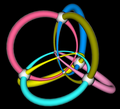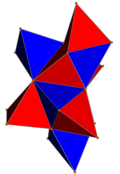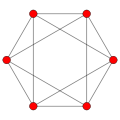16-cell
In four dimensional geometry, a 16-cell, is a regular convex polychoron, or polytope existing in four dimensions. It is also known as the hexadecachoron. It is one of the six regular convex polychora first described by the Swiss mathematician Ludwig Schläfli in the mid-19th century.
Conway calls it an orthoplex for orthant complex, as well as the entire class of cross-polytopes.
Geometry
The hexadecachoron is a member of the family of polytopes called the cross-polytopes, which exist in all dimensions. As such, its dual polychoron is the tesseract (the 4-dimensional hypercube).
It is bounded by 16 cells, all of which are regular tetrahedra. It has 32 triangular faces, 24 edges, and 8 vertices. The 24 edges bound 6 squares lying in the 6 coordinate planes.
The eight vertices of the hexadecachoron are (±1, 0, 0, 0), (0, ±1, 0, 0), (0, 0, ±1, 0), (0, 0, 0, ±1). All vertices are connected by edges except opposite pairs.
The Schläfli symbol of the hexadecachoron is {3,3,4}. Its vertex figure is a regular octahedron. There are 8 tetrahedra, 12 triangles, and 6 edges meeting at every vertex. Its edge figure is a square. There are 4 tetrahedra and 4 triangles meeting at every edge.
There is a lower symmetry form of the 16-cell, called a demitesseract or 4-demicube, a member of the demihypercube family, and represented by h{4,3,3}, and can be drawn bicolored with alternating tetrahedral cells.
Images
A skew orthogonal projection inside its regular octagonal Petrie polygon, connecting all vertices except opposite ones.
The 16-cell has two Wythoff constructions, a regular form and alternated form, shown here as nets, the second being represented by alternately two colors of tetrahedral cells.
A 3D projection of a 16-cell performing a double rotation about two orthogonal planes.
Tessellations
One can tessellate 4-dimensional Euclidean space by regular 16-cells. This is called the hexadecachoric honeycomb and has Schläfli symbol {3,3,4,3}. The dual tessellation, icositetrachoric honeycomb, {3,4,3,3}, is made of by regular 24-cells. Together with the tesseractic honeycomb {4,3,3,4}, these are the only three regular tessellations of R4. Each 16-cell has 16 neighbors with which it shares an octahedron, 24 neighbors with which it shares only an edge, and 72 neighbors with which it shares only a single point. Twenty-four 16-cells meet at any given vertex in this tessellation.
Projections
The cell-first parallel projection of the 16-cell into 3-space has a cubical envelope. The closest and farthest cells are projected to inscribed tetrahedra within the cube, corresponding with the two possible ways to inscribe a regular tetrahedron in a cube. Surrounding each of these tetrahedra are 4 other (non-regular) tetrahedral volumes that are the images of the 4 surrounding tetrahedral cells, filling up the space between the inscribed tetrahedron and the cube. The remaining 6 cells are projected onto the square faces of the cube. In this projection of the 16-cell, all its edges lie on the faces of the cubical envelope.
The cell-first perspective projection of the 16-cell into 3-space has a triakis tetrahedral envelope. The layout of the cells within this envelope are analogous to that of the cell-first parallel projection.
The vertex-first parallel projection of the 16-cell into 3-space has an octahedral envelope. This octahedron can be divided into 8 tetrahedral volumes, by cutting along the coordinate planes. Each of these volumes is the image of a pair of cells in the 16-cell. The closest vertex of the 16-cell to the viewer projects onto the center of the octahedron.
Finally the edge-first parallel projection has a shortened octahedral envelope, and the face-first parallel projection has a hexagonal bipyramidal envelope.
16-cell Media
Related pages
References
- H. S. M. Coxeter, Regular Polytopes, 3rd. ed., Dover Publications, 1973. ISBN 0-486-61480-8.
Other websites
- Eric W. Weisstein, 16-Cell at MathWorld.
- Olshevsky, George, Hexadecachoron at Glossary for Hyperspace.
- Der 16-Zeller (16-cell) Marco Möller's Regular polytopes in R4 (German)
- Description and diagrams of 16-cell projections Archived 2020-11-07 at the Wayback Machine











